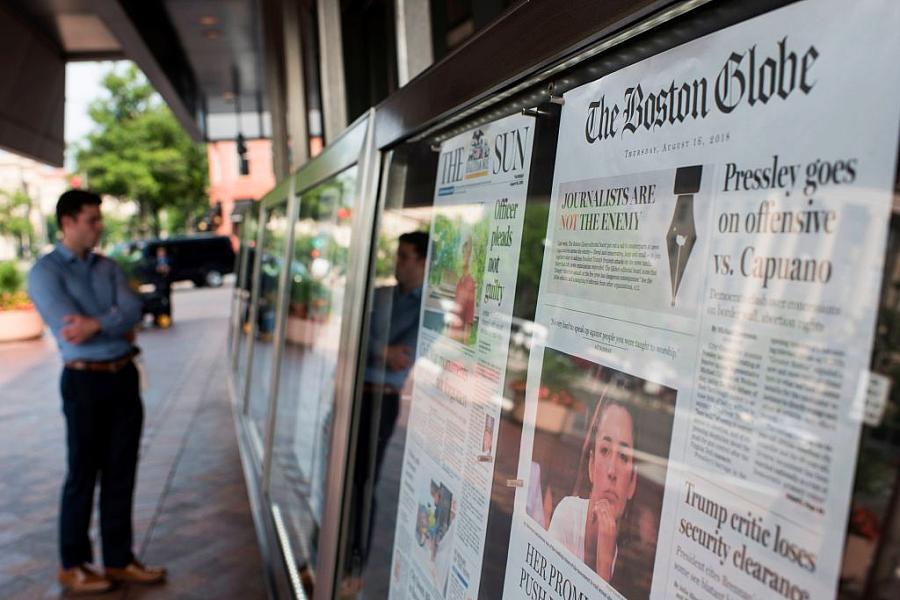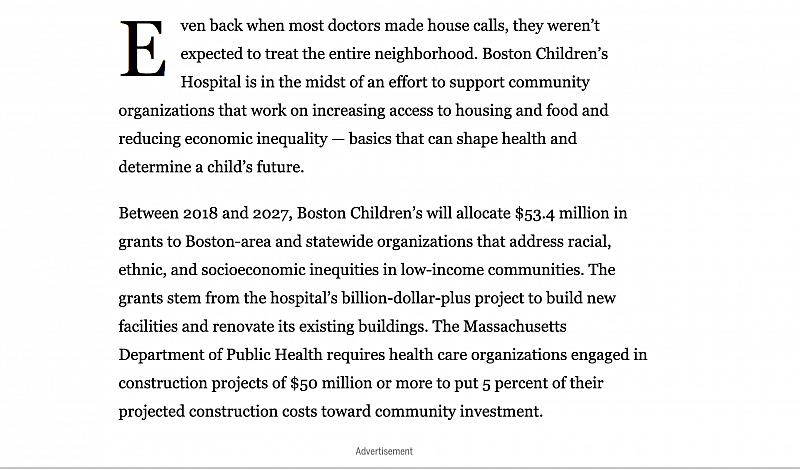Sneaky advertorials dupe readers and undermine worthy health coverage

(Photo: Eric Baradat/AFP/Getty Images)
While perusing the health news recently, I saw an article about a hospital investing in community groups to improve health. The Boston Globe article was about Boston Children’s Hospital, one of the largest and most highly-ranked pediatric medical centers in the country. The article discusses some of the nonprofits to which Boston Children’s will be donating over the next decade, painting the hospital as going “above and beyond” what other hospitals would fund. I enjoyed the article and moved on with other things.
A few hours later though, I happened upon another piece in the Globe about a surgical liaison who gives updates to families about how their loved one is doing in surgery, to help ease their anxieties. I was intrigued by the headline and started reading until I realized the story was also about Boston Children’s. Could that be a coincidence?
It was only at this point that I noticed an icon on the top left corner of the article that read, “Presented by Boston Children’s Hospital.” Now I knew it wasn’t a coincidence; it was an advertising campaign for the hospital disguised as news stories. I clicked on a link “for more on Boston Children’s 150th anniversary” and discovered an entire page on the Globe website dedicated to these sponsored articles. There were more than a dozen articles, all designed to showcase the best things about Boston Children’s, such as “Three ways technology is transforming care at Children’s Hospital,” “Meet the researchers working to curb childhood cancer,” and “The happiest tradition at Boston Children’s Hospital.”
Obviously hospitals should be able to tout their accomplishments, but doing it through sponsored news articles in the Globe seems sneaky. These “articles” are essentially glorified advertisements for Boston Children’s that the hospital is paying them to write; however, they have the same font and style as every other article in the Globe. As you can see from the two screenshots, the Boston Children’s article looks the same as the article about a shark stuck in a pond in Cape Cod (which is a pretty good read, in case you were wondering). The only difference is the icon at the top of the hospital article indicating that it is “presented by” Boston Children’s.
These advertisements disguised as news pieces are called “advertorials,” and they’re becoming more popular in health news because they work. Unsurprisingly, many people don’t realize they’re looking at sponsored content, because advertorials are designed not to look like an ad. According to a 2017 study by researchers at Dartmouth College and Stanford University, the design and structure of advertorials “tend to sway readers into believing that they are viewing credible information in the form of an editorial or news source.”

The advertorials for Boston Children’s in the Globe paint the hospital in a positive light, without including some important contextual information. For example, $53 million in donations to community groups sounds like a lot, but over the course of nine years, that’s about $6 million a year. To put that in context, Boston Children’s makes about $1.5 billion in revenue each year and just got a $1.2 billion expansion approved a few years ago.
In fact, the hospital’s expansion might be part of the reason why the Globe series exists in the first place. Boston Children’s received criticism last year for the expansion. The Massachusetts Health Policy Commission argued that the expansion, which the hospital presented as a way to add needed beds, was really about increasing the hospital’s “already substantial market share.” The consequence would be less competition and higher prices, raising health care costs in the state. Further, the expansion involved destroying a 60-year-old beloved healing garden, which was the resting place for many former Boston Children’s patients. None of these points were mentioned in the Globe series of articles, although they do include a piece boasting of the features in one of the new buildings.
In the past, the Globe has published a relatively balanced viewpoint on the Children’s expansion. They were not afraid to question whether the expansion was really necessary and made sure to get quotes from former patients about what they thought of the hospital’s new “healing garden” (“That’s not a healing garden. It’s kind of like a deck of a cruise ship where people can go out and have lunch.”) This new advertorial series makes me disappointed for the hardworking reporters and editors, who spent so much time crafting balanced stories on the hospital, only to have their efforts undermined by an advertising campaign disguised as news.
It’s unfortunate that readers have to watch out for sponsored content in disguise as health news, but when so much health journalism is beholden to sponsors, checking for advertorials has become essential.
An earlier version of this post ran on the Lown Institute's website.

